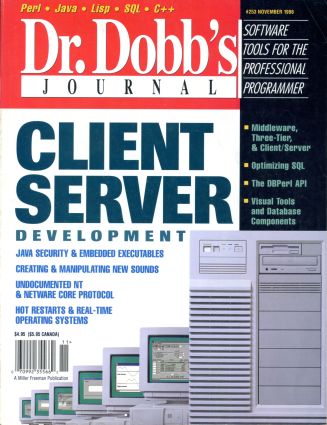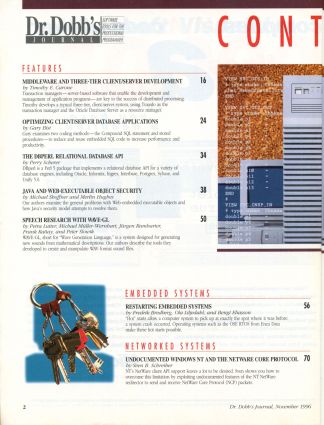
p.6 EDITORIAL
[author : Jonathan Erickson] #Edito
TABLE OF CONTENTS
FEATURES
p.16 MIDDLEWARE AND THREE-TIER CLIENT/SERVER DEVELOPMENT
[author : Timothy E. Carone]
Transaction managers-server-based software that enable the development and management of application programs-are key to the success of distributed processing. Timothy develops a typical three-tier, client/server system, using Tuxedo as the transaction manager and the Oracle Database Server as a resource manager.
p.24 OPTIMIZING CLIENT/SERVER DATABASE APPLICATIONS
[author : Gary Bist]
Gary examines two coding methods-the Compound SQL statement and stored procedures-to reduce and reuse embedded SQL code to increase performance and productivity.
p.34 THE DBPERL RELATIONAL DATABASE API
Perry Scherer
p.38 JAVA AND WEB-EXECUTABLE OBJECT SECURITY
[author : Michael Shoffner and Merlin Hughes]
Our authors examine the general problems with Web-embedded executable objects and how Java's security model attempts to resolve them.
p.50 SPEECH RESEARCH WITH WAVE-GL
[author : Petra Lutter, Michael Muller-Wernhart, Jurgen Ramharter, Frank Rattay, and Peter Slowik]
WAVE-GL, short for "Wave Generation Language," is a system designed for generating new sounds from mathematical descriptions. Our authors describe the tools they developed to create and manipulate WAV-format sound files.
EMBEDDED SYSTEMS
p.56 RESTARTING EMBEDDED SYSTEMS
[author : Fredrik Bredberg, Ola Liljedahl, and Bengt Eliasson]
"Hot" starts allow a computer system to pick up at exactly the spot where it was before a system crash occurred. Operating systems such as the OSE RTOS from Enea Data make these hot starts possible.
NETWORKED SYSTEMS
p.70 UNDOCUMENTED WINDOWS NT AND THE NETWARE CORE PROTOCOL
[author : Sven B. Schreiber]
NT's NetWare client API support leaves a lot to be desired. Sven shows you how to overcome this limitation by exploiting undocumented features of the NT NetWare redirector to send and receive NetWare Core Protocol (NCP) packets.
PROGRAMMER'S TOOLCHEST
p.80 EXAMINING THE SYSTEMS<TOOLKIT> LIBRARY
[author : Michael J. Vilot]
Systems<ToolKit> is a library that builds on the expressive foundation of the C++ Standard Library. It also adds iostream support to distributed C++ applications using sockets (and pipes, in the UNIX version) for IPC connections. Mike uses Systems<ToolKit> to develop a pair of distributed client/server applications for environments such as the Internet.
p.86 EXAMINING FORTE EXPRESS
[author : Nabil Hijazi]
Forte Express is a visual tool for client/server application development that generates the UI and database-access components of object-oriented, multi-tier applications.
COLUMNS
p.101 PROGRAMMING PARADIGMS
[author : Michael Swaine]
While examining multimedia-authoring tools, Michael realizes that if you give your users four ways to solve a problem, you don't really know what the problem is.
p.106 C PROGRAMMING
[author : Al Stevens]
Years of piano playing and programming finally pay off, as Al breaks into the exciting world of late-night TV. Not quite ready to give up his day gig, however, Al also shows how he converted a dialog-based MFC application to use the Property Sheet/Property Page idiom.
p.111 JAVA Q&A
[author : Cliff Berg]
How threads work and how you can create a general-purpose event scheduler are Cliff's focus this month.
p.116 ALGORITHM ALLEY
[author : John Swartz]
The main idea behind LISP is that any data structure can be constructed from lists. Consequently, John turns to this language when in need of a simple solution to complex combination problems.
p.119 UNDOCUMENTED CORNER
[author : Robert R. Collins]
Robert presents a processor-detection algorithm that doesn't use Intel's CPUID instruction.
p.128 PROGRAMMER'S BOOKSHELF
[author : Eric McRae]
Eric examines The Benchmark Book, by Richard Grace, and C Algorithms for Real-Time DSP, by Paul M. Embree.
FORUM
p.8 LETTERS
[author : you]
p.12 NEWS & VIEWS
[author : the DDJ staff]
p.136 SWAINE'S FLAMES
[author : Michael Swaine]
PROGRAMMER'S SERVICES
p.130 OF INTEREST
[author : Eugene Eric Kim]

